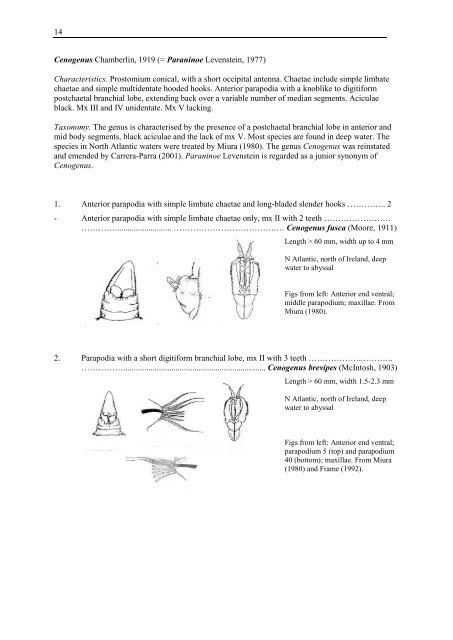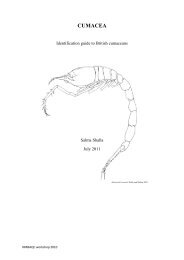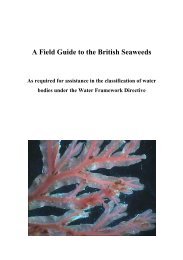Guide to identification of Lumbrineridae - NMBAQC
Guide to identification of Lumbrineridae - NMBAQC
Guide to identification of Lumbrineridae - NMBAQC
Create successful ePaper yourself
Turn your PDF publications into a flip-book with our unique Google optimized e-Paper software.
14<br />
Cenogenus Chamberlin, 1919 (= Paraninoe Levenstein, 1977)<br />
Characteristics. Pros<strong>to</strong>mium conical, with a short occipital antenna. Chaetae include simple limbate<br />
chaetae and simple multidentate hooded hooks. Anterior parapodia with a knoblike <strong>to</strong> digitiform<br />
postchaetal branchial lobe, extending back over a variable number <strong>of</strong> median segments. Aciculae<br />
black. Mx III and IV unidentate. Mx V lacking.<br />
Taxonomy. The genus is characterised by the presence <strong>of</strong> a postchaetal branchial lobe in anterior and<br />
mid body segments, black aciculae and the lack <strong>of</strong> mx V. Most species are found in deep water. The<br />
species in North Atlantic waters were treated by Miura (1980). The genus Cenogenus was reinstated<br />
and emended by Carrera-Parra (2001). Paraninoe Levenstein is regarded as a junior synonym <strong>of</strong><br />
Cenogenus.<br />
1. Anterior parapodia with simple limbate chaetae and long-bladed slender hooks ………….. 2<br />
- Anterior parapodia with simple limbate chaetae only, mx II with 2 teeth ……………………<br />
…………........................... ……………………………….… Cenogenus fusca (Moore, 1911)<br />
Length > 60 mm, width up <strong>to</strong> 4 mm<br />
N Atlantic, north <strong>of</strong> Ireland, deep<br />
water <strong>to</strong> abyssal<br />
Figs from left: Anterior end ventral;<br />
middle parapodium; maxillae. From<br />
Miura (1980).<br />
2. Parapodia with a short digitiform branchial lobe, mx II with 3 teeth ………………..………..<br />
…………….................................................................... Cenogenus brevipes (McIn<strong>to</strong>sh, 1903)<br />
Length > 60 mm, width 1.5-2.3 mm<br />
N Atlantic, north <strong>of</strong> Ireland, deep<br />
water <strong>to</strong> abyssal<br />
Figs from left: Anterior end ventral;<br />
parapodium 5 (<strong>to</strong>p) and parapodium<br />
40 (bot<strong>to</strong>m); maxillae. From Miura<br />
(1980) and Frame (1992).




